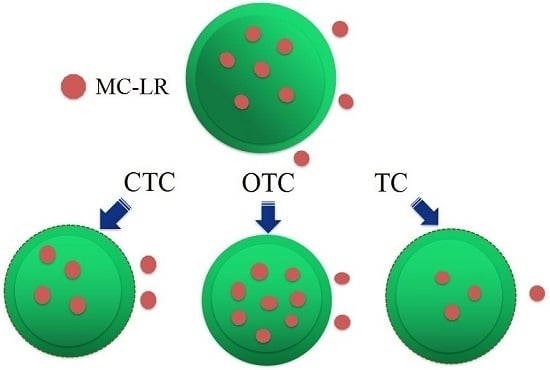Toxin Release of Cyanobacterium Microcystis aeruginosa after Exposure to Typical Tetracycline Antibiotic Contaminants
Abstract
:1. Introduction
2. Results
2.1. Exposure Concentrations of the Chemicals
2.2. Growth Curves of M. aeruginosa
2.3. ELISA Detection of MC-LR in the CTC-Treated Samples
2.4. ELISA Detection of MC-LR in the OTC-Treated Samples
2.5. ELISA Detection of MC-LR in the TC-Treated Samples
3. Discussion
3.1. Toxicity of the Antibiotics to M. aeruginosa
3.2. Influence of Antibiotics on MC-LR Production and Release in M. aeruginosa
4. Conclusions
5. Materials and Methods
5.1. Chemicals and Cell Culture
5.2. Growth Characteristic Tests
5.3. Analysis of the Exposure Concentrations
5.4. MC-LR Analysis
5.5. Data Analysis
Acknowledgments
Author Contributions
Conflicts of Interest
References
- Baguer, A.J.; Jensen, J.; Krogh, P.H. Effects of the antibiotics oxytetracycline and tylosin on soil fauna. Chemosphere 2000, 40, 751–757. [Google Scholar] [CrossRef]
- European Commission (IP/02/1720) Byrne welcomes Parliament vote on safer rules for feed additives prohibition of antibiotics as growth promoters confirmed. Available online: http://europa.eu/rapid/press-release_IP-02-1720_en.htm. Brussels (accessed on 21 November 2016).
- Mellon, M.; Benbrook, C.; Benbrook, K.L. Hogging It: Estimates of Antimicrobial Abuse in Livestock; Union of Concerned Scientists: Cambridge, MA, USA, 2001; p. 109. [Google Scholar]
- Liu, B.; Liu, W.; Nie, X.; Guan, C.; Yang, Y.; Wang, Z.; Liao, W. Growth response and toxic effects of three antibiotics on Selenastrum capricornutum evaluated by photosynthetic rate and chlorophyll biosynthesis. J. Environ. Sci.-China 2011, 23, 1558–1563. [Google Scholar] [CrossRef]
- Qian, H.; Li, J.; Pan, X.; Sun, Z.; Ye, C.; Jin, G.; Fu, Z. Effects of streptomycin on growth of algae Chlorella vulgaris and Microcystis aeruginosa. Environ. Toxicol. 2012, 27, 229–237. [Google Scholar] [CrossRef] [PubMed]
- Stoichev, T.; Baptista, M.S.; Basto, M.C.P.; Vasconcelos, V.M.; Vasconcelos, M.T.S.D. Effects of minocycline and its degradation products on the growth of Microcystis aeruginosa. Ecotoxicol. Environ. Saf. 2011, 74, 219–224. [Google Scholar] [CrossRef] [PubMed]
- Watkinson, A.J.; Murby, E.J.; Kolpin, D.W.; Costanzo, S.D. The occurrence of antibiotic in an urban watershed: From wastewater to drinking water. Sci. Total Environ. 2009, 407, 2711–2723. [Google Scholar] [CrossRef] [PubMed]
- Chen, J.Q.; Guo, R.X. Access the toxic effect of the antibiotic cefradine and its UV light degradation products on two freshwater algae. J. Hazard. Mater. 2012, 209–210, 520–523. [Google Scholar] [CrossRef] [PubMed]
- Hirsh, R.; Ternes, T.; Haberer, K.; Kratz, K.L. Occurrence of antibiotics in the aquatic environment. Sci. Total Environ. 2009, 225, 109–118. [Google Scholar] [CrossRef]
- Lanzky, P.F.; Halling-Sørensen, B. The toxic effect of the antibiotic metronidazole on aquatic organisms. Chemosphere 1997, 35, 2553–2561. [Google Scholar] [CrossRef]
- Fent, K.; Weston, A.A.; Caminada, D. Ecotoxicology of human pharmaceuticals. Aquat. Toxicol. 2006, 76, 122–159. [Google Scholar] [CrossRef] [PubMed]
- Stanier, R.Y.; Bazine, G.C. Phototrophic prokaryotes: The cyanobacteria. Annu. Rev. Microbiol. 1977, 31, 225–274. [Google Scholar] [CrossRef] [PubMed]
- Halling-Sørensen, B.; Holten-Lützhøft, H.C.; Andersen, H.R.; Ingerslev, F. Environmental risk assessment of antibiotics: Comparison of mecillinam, trimethoprim and ciprofloxacin. J. Antimicrob. Chemother. 2000, 46 (Suppl. S1), 53–58. [Google Scholar] [CrossRef] [PubMed]
- European Medicine Agency (EMEA). Guideline on the Environmental Risk Assessment of Medicinal Products for Human Use; Doc Ref. EMEA/CHMP/SWP/4447/00; European Medicine Agency: London, UK, 2006. [Google Scholar]
- Van der Grinten, E.; Pikkemaat, M.G.; van den Brandhof, E.J.; Stroomberg, G.J.; Kraak, M.H.S. Comparing the sensitivity of algal, cyanobacterial and bacterial bioassays to different groups of antibiotics. Chemosphere 2010, 80, 1–6. [Google Scholar] [CrossRef] [PubMed]
- Dias, E.; Oliveira, M.; Jones-Dias, D.; Vasconcelos, V.; Ferreira, E.; Manageiro, V.; Canica, M. Assessing the antibiotic susceptibility of freshwater Cyanobacteria spp. Front. Microbiol. 2015, 6, 799–807. [Google Scholar] [CrossRef] [PubMed]
- Kolar, B.; Arnus, L.; Jeretin, B.; Gutmaher, A.; Drobne, D.; Durjava, M. The toxic effect of oxytetracycline and trimethoprim in the aquatic environment. Chemosphere 2014, 115, 75–80. [Google Scholar] [CrossRef] [PubMed]
- Guo, R.; Chen, J. Phytoplankton toxicity of the antibiotic chlortetracycline and its UV light degradation products. Chemosphere 2012, 87, 1254–1259. [Google Scholar] [CrossRef] [PubMed]
- González-Pleiter, M.; Gonzalo, S.; Rodea-Palomares, I.; Leganés, F.; Rosal, R.; Boltes, K.; Marco, E.; Fernández-Piñas, F. Toxicity of five antibiotics and their mixtures towards photosynthetic aquatic organisms: Implications for environmental risk assessment. Water Res. 2013, 47, 2050–2064. [Google Scholar] [CrossRef] [PubMed]
- Liu, Y.; Gao, B.; Yue, Q.; Guan, Y.; Wang, Y.; Huang, L. Influences of two antibiotic contaminants on the production, release and toxicity of microcystins. Ecotoxicol. Environ. Saf. 2012, 77, 79–87. [Google Scholar] [CrossRef] [PubMed]
- Liu, F.; Ying, G.; Tao, R.; Zhao, J.; Yang, J.; Zhao, L. Effects of six selected antibiotics on plant growth and soil microbial and enzymatic activities. Environ. Pollut. 2009, 157, 1636–1642. [Google Scholar] [CrossRef] [PubMed]
- Jesús García-Galán, M.; Díaz-Cruz, S.; Barceló, D. Combining chemical analysis and ecotoxicity to determine environmental exposure and to assess risk from sulfonamides. TrAC Trends Anal. Chem. 2009, 28, 804–819. [Google Scholar] [CrossRef]
- Halling-Sørensen, B.; Nors Nielsen, S.; Lanzky, P.F.; Ingerslev, F.; Holten Lützhøft, H.C.; Jørgensen, S.E. Occurrence, fate and effects of pharmaceutical substances in the environment-A review. Chemosphere 1998, 36, 357–393. [Google Scholar] [CrossRef]
- Isidori, M.; Lavorgna, M.; Nardelli, A.; Pascarella, L.; Parrella, A. Toxic and genotoxic evaluation of six antibiotics on non-target organisms. Sci. Total Environ. 2005, 346, 87–98. [Google Scholar] [CrossRef] [PubMed]
- Macrì, A.; Stazi, A.V.; Dojmi Di Delupis, G. Acute toxicity of furazolidone on Artemia salina, Daphnia magna, and Culex pipiens molestus larvae. Ecotoxicol. Environ. Saf. 1988, 16, 90–94. [Google Scholar] [CrossRef]
- Ando, T.; Nagase, H.; Equchi, K.; Hirooka, T.; Nakamura, T.; Hirata, K. A novel method using cyanobacteria for ecotoxicity test of veterinary antimicrobial agents. Environ. Toxicol. Chem. 2007, 26, 601–606. [Google Scholar] [CrossRef] [PubMed]
- Holten Lützhøft, H.C.; Halling-Sørensen, B.; Jørgensen, S.E. Algal toxicity of antibacterial agents applied in Danish fish farming. Arch. Environ. Contam. Toxicol. 1999, 36, 1–6. [Google Scholar]
- Babica, P.; Bláha, L.; Maršálek, B. Exploring the natural role of microcystins—A review of effects on photoautotrophic organisms. J. Phycol. 2006, 42, 9–20. [Google Scholar] [CrossRef]
- Jewel, M.A.S.; Affan, M.A.; Khan, S. Fish mortality due to cyanobacterial bloom in an aquaculture pond in Bangladesh. Pakistan J. Biol. Sci. 2003, 6, 1046–1050. [Google Scholar]
- White, S.H.; Duivenvoorden, L.J.; Fabbro, L.D. A decision-making framework for ecological impacts associated with the accumulation of cyanotoxins (cylindrospermopsin and microcystin). Lake Reserv. Res. Manag. 2005, 10, 25–37. [Google Scholar] [CrossRef]
- Downing, E.G.; Meyer, C.; Gehringger, M.M.; Van de Venter, M. Microcystin content of Microcystis aeruginosa is modulated by nitrogen uptake rate relative to specific growth rate or carbon fixation rate. Environ. Toxicol. 2005, 20, 257–262. [Google Scholar] [CrossRef] [PubMed]
- Ye, J.; Zhang, Y.; Chen, S.; Liu, C.; Zhu, Y.; Liu, W. Enantioselective changes in oxidative stress and toxin release in Microcystis aeruginosa exposed to chiral herbicide diclofop acid. Aquat. Toxicol. 2014, 146, 12–19. [Google Scholar] [CrossRef] [PubMed]
- Dittmann, E.; Neilan, B.A.; Erhard, M.; von Dőrner, T. Insertional mutagenesis of a peptide synthetase gene that is responsible for hepatotoxin production in the cyanobacterium Microcystis aeruginosa PCC 7806. Mol. Microbiol. 1997, 26, 779–787. [Google Scholar] [CrossRef] [PubMed]
- Hagenbuch, I.M.; Pinckney, J.L. Toxic effect of the combined antibiotics ciprofloxacin, lincomycin, and tylosin on two species of marine diatoms. Water Res. 2012, 46, 5028–5036. [Google Scholar] [CrossRef] [PubMed]
- Daughton, C.G.; Ternes, T.A. Pharmaceuticals and personal care products in the environment: Agents of subtle change? Environ. Health Perspect. 1990, 107, 907–938. [Google Scholar] [CrossRef]
- Calamari, D.; Zuccato, E.; Castiglioni, S.; Bagnati, R.; Fanelli, R. Strategic survey of therapeutic drugs in the rivers Po and Lambro in northern Italy. Environ. Sci. Technol. 2003, 37, 1241–1248. [Google Scholar] [CrossRef]
- Zuccato, E.; Castiglioni, S.; Fanelli, R. Identification of the pharmaceuticals for human use contaminating the Italian aquatic environment. J. Hazard. Mater. 2005, 122, 205–209. [Google Scholar] [CrossRef] [PubMed]
- Feitosa-Felizzola, J.; Chiron, S. Occurrence and distribution of selected antibiotics in a small Mediterranean stream (Arc River, Southern France). J. Hydrol. 2009, 364, 50–57. [Google Scholar] [CrossRef]
- Organization for Economic Cooperation and Development. Freshwater Alga and Cyanobacteria, Growth Inhibition and Test; OECD Guidelines for the Testing of Chemicals (201); Organization for Economic Cooperation and Development: Paris, France, 2006. [Google Scholar]
- Wu, L.; Qiu, Z.; Zhou, Y.; Du, Y.; Liu, C.; Ye, J.; Hu, X. Physiological effects of the herbicide glyphosate on the cyanobacterium Microcystis aeruginosa. Aquat. Toxicol. 2016, 178, 72–79. [Google Scholar] [CrossRef] [PubMed]
- Gkelis, S.; Zaoutsos, N. Cyanotoxin occurrence and potentially toxin producing cyanobacteria in freshwaters of Greece: A multi-disciplinary approach. Toxicon 2014, 78, 1–9. [Google Scholar] [CrossRef] [PubMed]
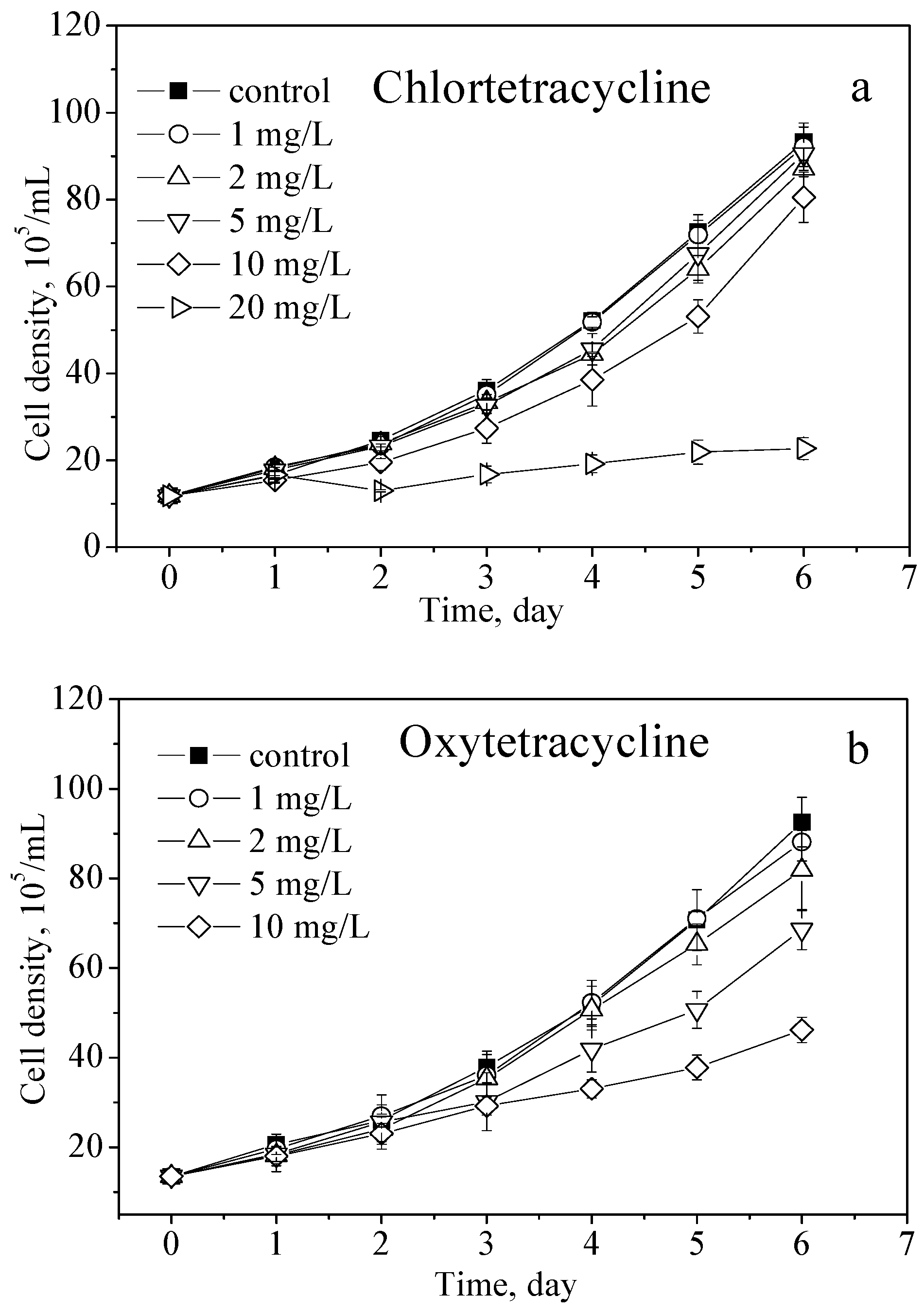
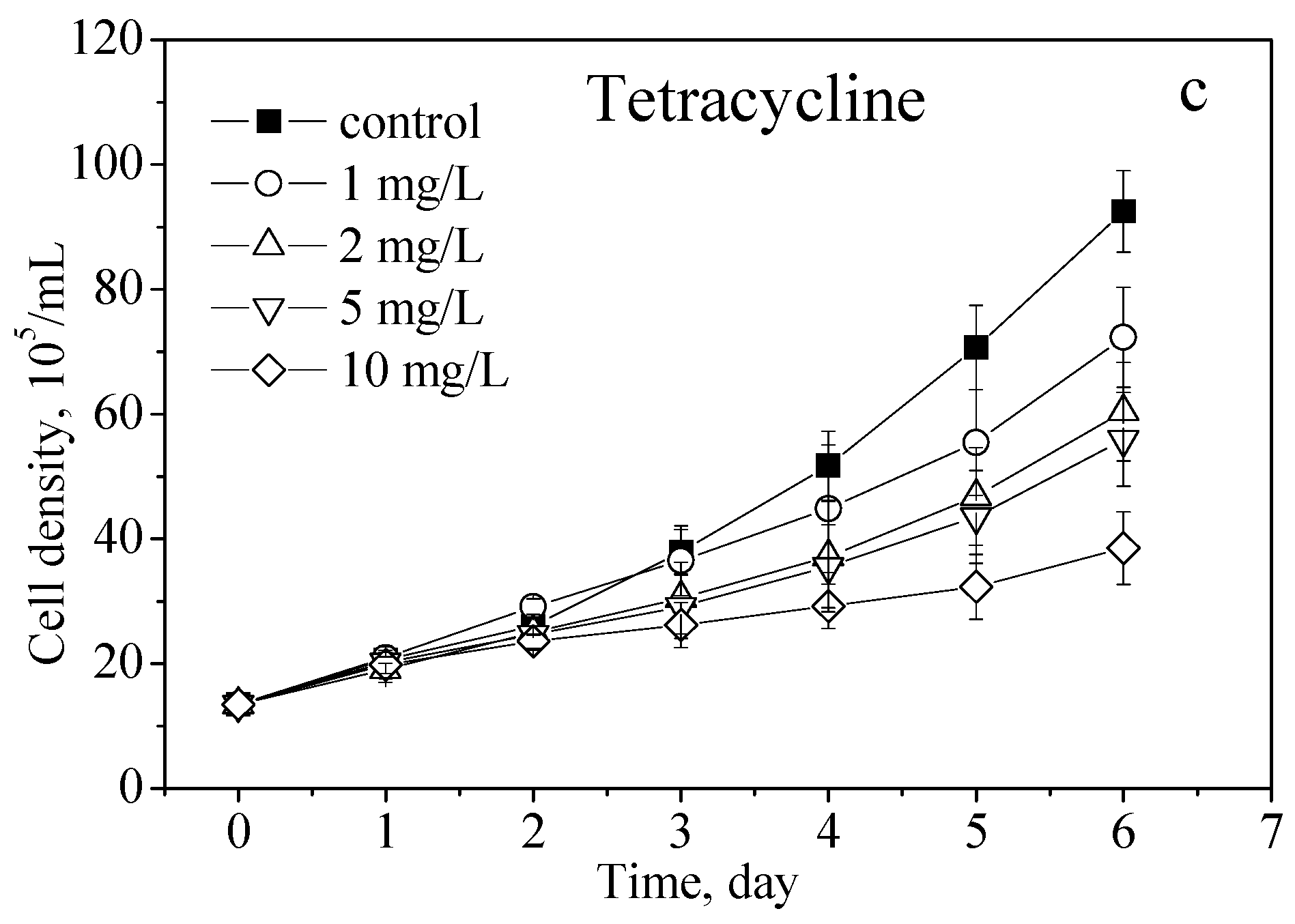
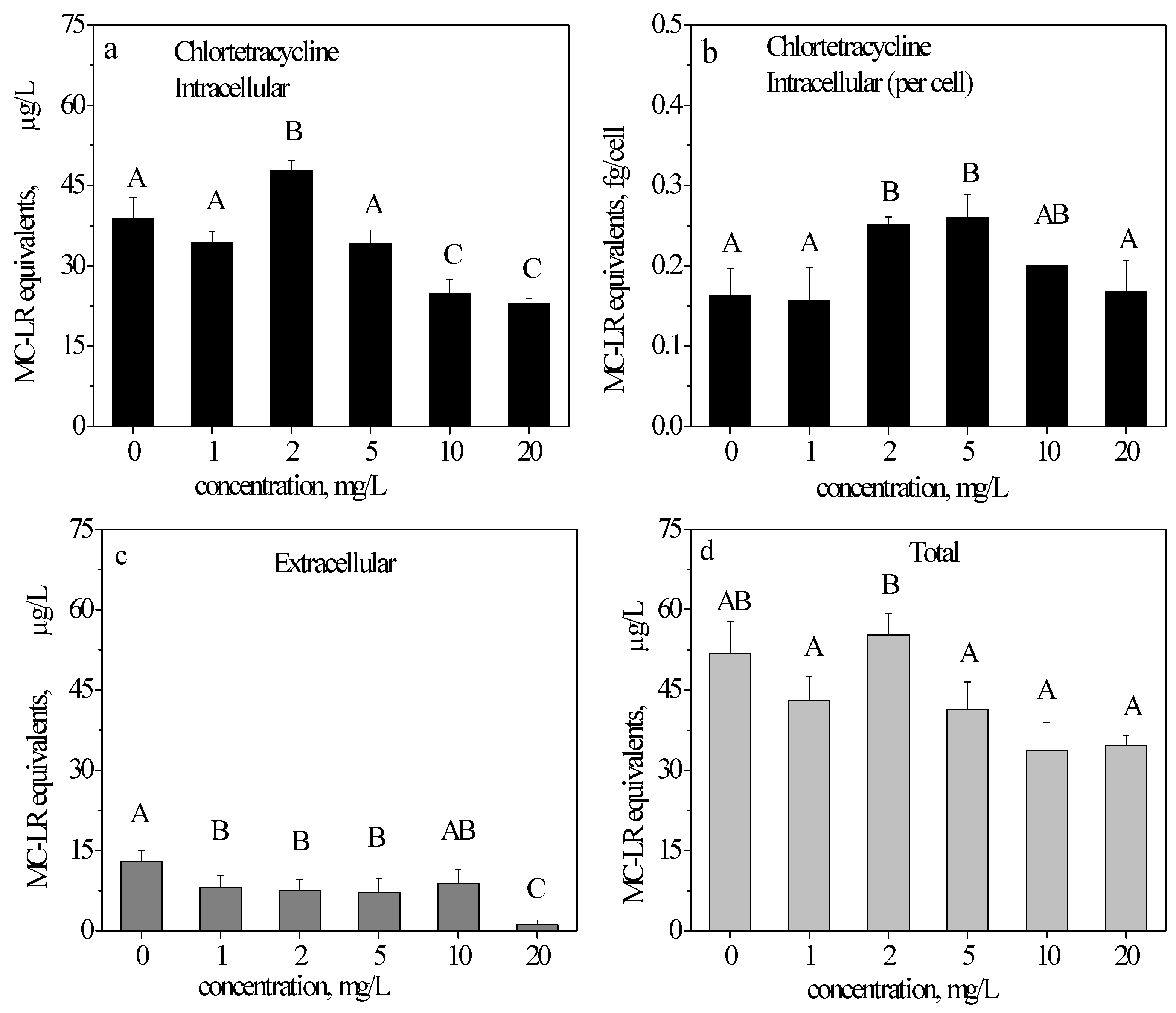
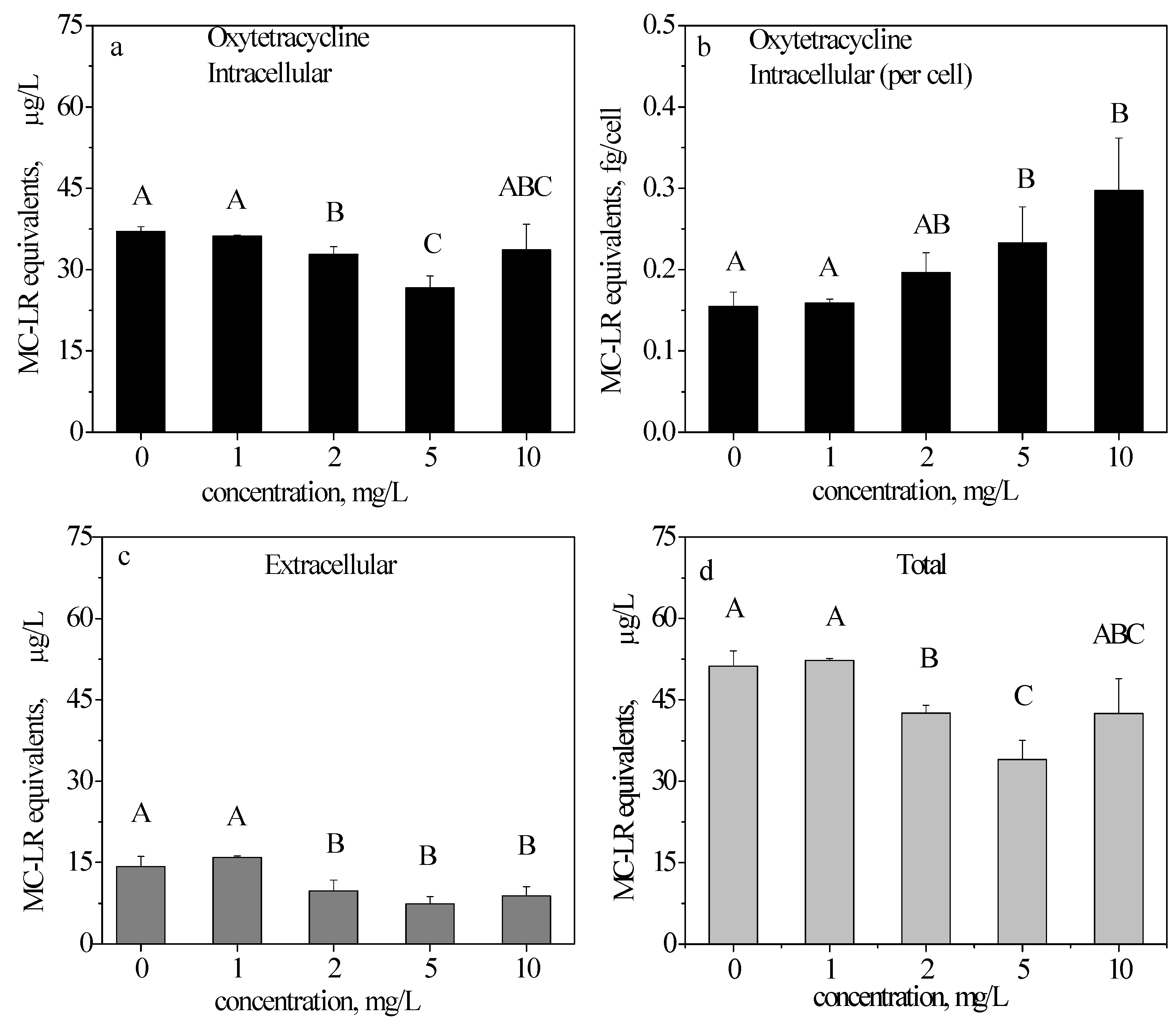
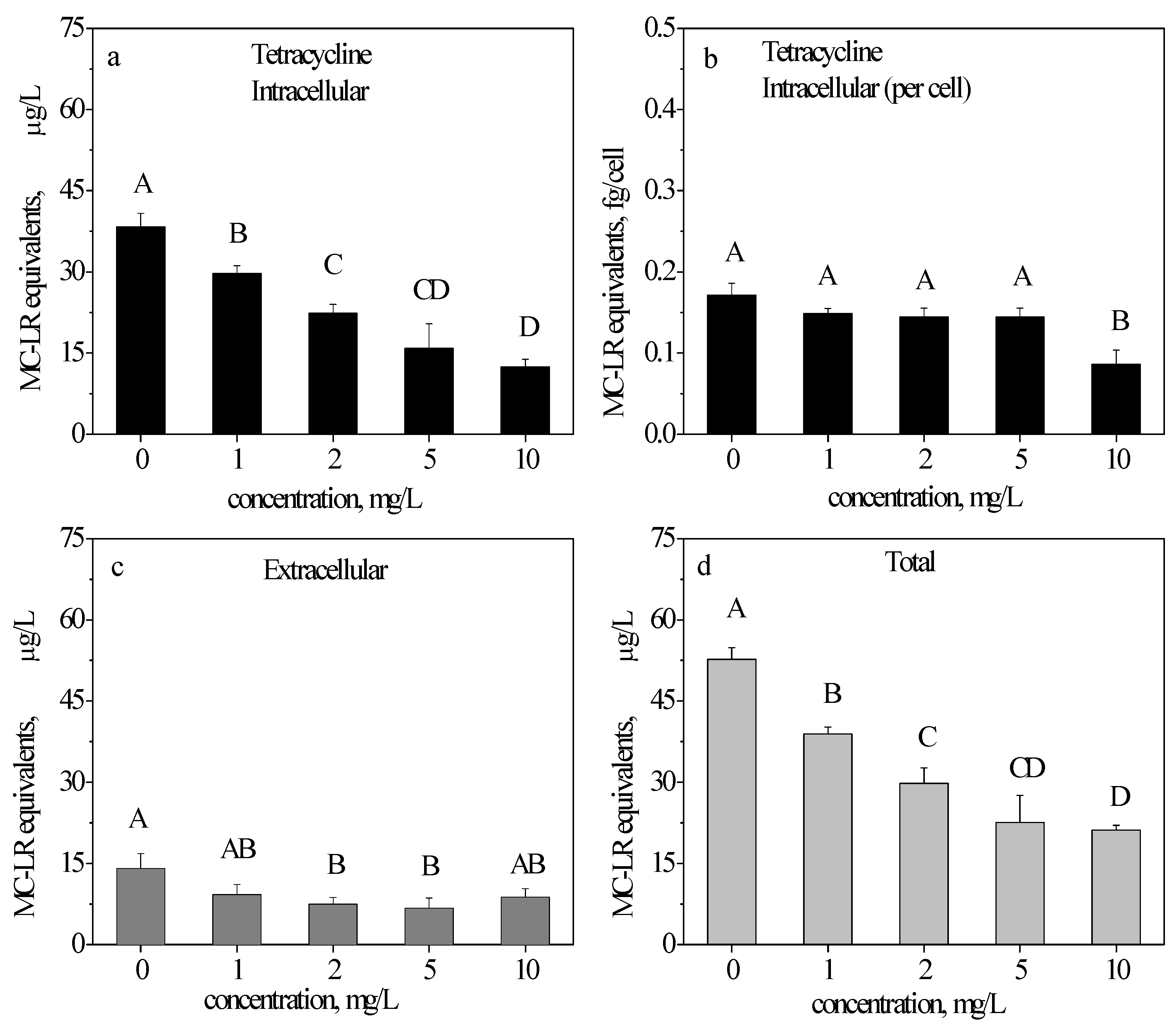
| ECx | CTC (mg/L) | OTC (mg/L) | TC (mg/L) |
|---|---|---|---|
| r2 | 0.92 | 0.98 | 0.88 |
| EC10 | 1.86 | 3.02 | 0.63 |
| EC20 | 4.09 | 4.86 | 1.58 |
| Concentration (mg/L) | CTC | OTC | TC | ||||||
|---|---|---|---|---|---|---|---|---|---|
| NF a | tc | k b | NF | tc | k | NF | tc | k | |
| 0 | 93.35 | 3.43 | 0.62 (A ) | 92.52 | 3.36 | 0.56 (A′) | 92.52 | 3.36 | 0.56 (A″) |
| 1 | 92.15 | 3.41 | 0.61 (A) | 88.12 | 3.15 | 0.60 (B′) | 72.34 | 2.85 | 0.51 (A″B″) |
| 2 | 87.06 | 3.60 | 0.54 (AB) | 81.82 | 3.11 | 0.60 (B′) | 60.41 | 2.73 | 0.47 (A″B″) |
| 5 | 90.48 | 3.65 | 0.56 (AB) | 68.60 | 3.08 | 0.48 (C′) | 55.95 | 2.52 | 0.45 (B″) |
| 10 | 80.53 | 4.05 | 0.48 (B) | 46.17 | 1.93 | 0.48 (C′) | 38.53 | 1.15 | 0.43 (B″) |
| 20 | 22.70 | 0.22 | 0.54 (AB) | - | - | - | - | - | - |
© 2017 by the authors. Licensee MDPI, Basel, Switzerland. This article is an open access article distributed under the terms and conditions of the Creative Commons Attribution (CC BY) license ( http://creativecommons.org/licenses/by/4.0/).
Share and Cite
Ye, J.; Du, Y.; Wang, L.; Qian, J.; Chen, J.; Wu, Q.; Hu, X. Toxin Release of Cyanobacterium Microcystis aeruginosa after Exposure to Typical Tetracycline Antibiotic Contaminants. Toxins 2017, 9, 53. https://doi.org/10.3390/toxins9020053
Ye J, Du Y, Wang L, Qian J, Chen J, Wu Q, Hu X. Toxin Release of Cyanobacterium Microcystis aeruginosa after Exposure to Typical Tetracycline Antibiotic Contaminants. Toxins. 2017; 9(2):53. https://doi.org/10.3390/toxins9020053
Chicago/Turabian StyleYe, Jing, Yuping Du, Lumei Wang, Jingru Qian, Jiejing Chen, Qingwen Wu, and Xiaojun Hu. 2017. "Toxin Release of Cyanobacterium Microcystis aeruginosa after Exposure to Typical Tetracycline Antibiotic Contaminants" Toxins 9, no. 2: 53. https://doi.org/10.3390/toxins9020053
APA StyleYe, J., Du, Y., Wang, L., Qian, J., Chen, J., Wu, Q., & Hu, X. (2017). Toxin Release of Cyanobacterium Microcystis aeruginosa after Exposure to Typical Tetracycline Antibiotic Contaminants. Toxins, 9(2), 53. https://doi.org/10.3390/toxins9020053




